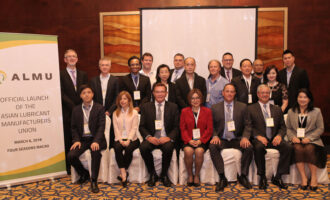A hydrogen future
One path to a zero-emission future involves hydrogen. When used in a fuel cell, hydrogen helps produce electricity to power a vehicle. These fuel cell vehicles (FCVs) have attractive attributes.
“It is considered a zero emission vehicle,” said Eiji Ohira, director of the Fuel Cell and Hydrogen Technology Group at the New Energy and Industrial Technology Development Organization (NEDO). Based in Kawasaki City, NEDO is Japan’s largest public research organisation, particularly in the area of new energy. Hydrogen-powered vehicles have a range of hundreds of kilometres on just a few kilograms of the fuel, Ohira told the 2015 JSAE/SAE Powertrains, Fuels and Lubricants International Meeting in Kyoto, Japan in September.
Seiji Sano, project general manager in the R&D management division of Toyota Motor Corp., outlined the vehicle maker’s latest innovations in fuel cell technology. These include catalysts with higher reactivity, thinner electrolyte membranes and a 3D fine mesh to promote even air flow and water expulsion, a byproduct of the electricity-producing reaction. The result is much greater power out of the fuel cell, which translates to greater range, higher speed or some combination of the two.
Speaking of Toyota’s latest efforts in this area, Sano said that vehicle costs have “been reduced significantly from previous models, but it’s not sufficient for mass production.”
Nonetheless, Toyota introduced an FCV, the Mirai, which means future in Japanese, in Japan last year. It is introducing it in Europe and the United States for the 2016 model year. In the U.S., the suggested retail price is USD 57,500, making it more expensive than the Mercedes-Benz C Class, Range Rover Evoque, Acura TLX and similar cars.
Building a hydrogen infrastructure will be a slow and expensive process. Japan is on track to have 100 or so stations by early 2016, Ohira said. That represents a considerable investment because a hydrogen refueling station costs hundreds of millions of yen. In comparison, a fast-recharging station for electric vehicles costs less than JPY 10 million (USD 83,301).
To offset this, the Japanese government is offering subsidies of up to 80% of the cost of a hydrogen refueling station, making it about as expensive as a petrol station. Reportedly, a subsidy will cover more than half the cost of the fuel. What’s more, Japanese buyers will be entitled to subsidies of up to JPY 3 million (USD 25,000) for the purchase of an FCV. That’s 41% of the Mirai’s price tag of JPY 7.2 million (USD 59,977).
Toyota believes that an electric vehicle won’t have the range of an FCV, because of the battery’s limited power storage capacity. Also, the recharging time for an EV takes hours versus the five minutes or so to refill a hydrogen vehicle’s tank.
In California, there will soon be more than 50 hydrogen refueling stations. That is well on the way to the nearly 70 needed for commercial viability, said Brendan Shaffer, technology manager and senior research scientist for sustainable energy at the University of California, Irvine.
In his JSAE presentation, Shaffer discussed the economics of hydrogen refueling. He went over modeling that has been done of a 68-station network of hydrogen-refueling stations, with the locations chosen to satisfy expected consumer demand. In estimating what that demand might be, researchers turned to the history of hybrid electric vehicle (HEV) sales in the United States.
“If fuel cell vehicles follow historic HEV sales, you could achieve positive cash flow for that refueling station network within five years,” Shaffer said.
The International Energy Agency (IEA), which launched the “Technology Roadmap on Hydrogen and Fuel Cells” in June, noted the need to develop a hydrogen transmission distribution and retail network and the need for cost efficient hydrogen generation with a low-carbon footprint. “These are difficult, but not insurmountable challenges,” said IEA Executive Director Maria van der Hoeven.
“Hydrogen is particularly useful as an energy carrier because it allows low-carbon energy to be stored. Small quantities of hydrogen can be stored under restricted space and weight requirements to enable long-distance, low carbon driving using fuel cell electric vehicles,” she said.
However, while hydrogen-based products are appearing and infrastructure is being developed, it is by no means certain that hydrogen fuel will prevail. It took Toyota 10 years to sell a million units of its popular hybrid vehicle, the Prius. More importantly, the largest competitor of fuel cell vehicles today and 20 years down the road remains the internal combustion engine (ICE), which through boosting, turbocharging and downsizing has achieved significant fuel efficiencies. Indeed, at the JSAE conference Renault’s Philippe Schulz pointed out that ICE cars are improving by five percent a year or more in efficiency. In addition, ICE cars are more affordable than an FCV or HEV.
However, the need for zero-emission vehicles is imperative, said Shigeru Maruyama, Honda R&D’s general manager of the electric power plant technology division. Whether electric battery or hydrogen fuel cell powered, such vehicles are essential if the goal is sustainable mobility. As Maruyama said, “Carbon emissions must be reduced in the coming years.”
echo '







